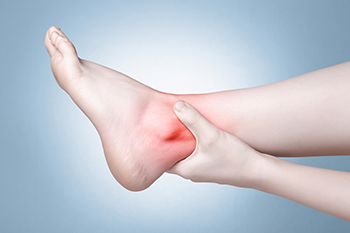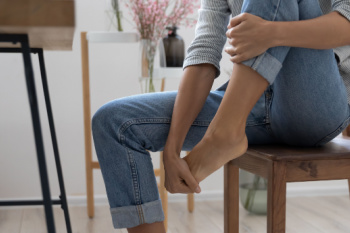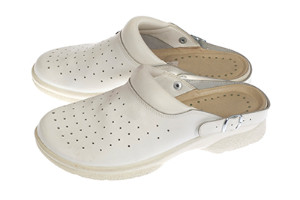
The ankle plays a key role in movement and balance, making it prone to a wide range of injuries and conditions. Twisting or rolling the joint can result in a ligament strain, which is one of the most frequent reasons for ankle pain. Bone breaks may follow a fall, sudden impact, or sports accident. Over time, repeated motion or poor foot mechanics can lead to tendon irritation. Some people also develop joint inflammation that makes walking more difficult as stiffness and swelling increase. Pain may be steady or sharp, and movement can become limited depending on the cause. Ignoring these signs may lead to long-term weakness or instability. Early attention and proper support can make a difference in how well the joint recovers. If you have a swollen, painful ankle, or if it feels unstable, it is suggested that you see a podiatrist who can accurately diagnose ankle pain, and offer effective relief and treatment solutions.
Ankle pain can be caused by a number of problems and may be potentially serious. If you have ankle pain, consult with Philip C. Caswell, DPM from Family Foot & Ankle Care. Our doctor will assess your condition and provide you with quality foot and ankle treatment.
Ankle pain is any condition that causes pain in the ankle. Due to the fact that the ankle consists of tendons, muscles, bones, and ligaments, ankle pain can come from a number of different conditions.
Causes
The most common causes of ankle pain include:
- Types of arthritis (rheumatoid, osteoarthritis, and gout)
- Ankle sprains
- Broken ankles
- Achilles tendonitis
- Achilles tendon rupture
- Stress fractures
- Bursitis
- Tarsal tunnel syndrome
- Plantar fasciitis
Symptoms
Symptoms of ankle injury vary based upon the condition. Pain may include general pain and discomfort, swelling, aching, redness, bruising, burning or stabbing sensations, and/or loss of sensation.
Diagnosis
Due to the wide variety of potential causes of ankle pain, podiatrists will utilize a number of different methods to properly diagnose ankle pain. This can include asking for personal and family medical histories and of any recent injuries. Further diagnosis may include sensation tests, a physical examination, and potentially x-rays or other imaging tests.
Treatment
Just as the range of causes varies widely, so do treatments. Some more common treatments are rest, ice packs, keeping pressure off the foot, orthotics and braces, medication for inflammation and pain, and surgery.
If you have any questions, please feel free to contact our office located in Sparta, NJ . We offer the newest diagnostic and treatment technologies for all your foot care needs.

Toe pain can result from many causes, including injury, joint problems, nail issues, or pressure from shoes that do not fit properly. It may come on suddenly or develop gradually, depending on the source. Common reasons include bunions, hammertoes, ingrown nails, arthritis, or stress from overuse. The affected toe may appear swollen, stiff, or red, and walking can become difficult. Choosing supportive shoes with a wide toe box and avoiding high heels can ease pressure and resting the foot may help reduce discomfort. Stretching and gentle movement can improve flexibility if stiffness is a problem. In some cases, padding, orthotics, or splints may be recommended to protect the toe and promote healing. While many cases respond to simple care, pain that does not improve should be evaluated. If toe discomfort is limiting your mobility or continues to worsen, it is suggested that you see a podiatrist for a diagnosis and appropriate treatment.
Toe pain can disrupt your daily activities. If you have any concerns, contact Philip C. Caswell, DPM of Family Foot & Ankle Care. Our doctor can provide the care you need to keep you pain-free and on your feet.
What Causes Toe Pain?
Most severe toe pain is caused due to a sports injury, trauma from dropping something heavy on the toe, or bumping into something rigid. Other problems can develop over time for various reasons.
Toe pain can be caused by one or more ailments. The most common include:
- Trauma
- Sports injury
- Wearing shoes that are too tight
- Arthritis
- Gout
- Corns and calluses
- Hammertoe
- Bunions
- Blisters
- Ingrown toenails
- Sprains
- Fractures (broken bones)
- Dislocations
When to See a Podiatrist
- Severe pain
- Persistent pain that lasts more than a week
- Signs of infection
- Continued swelling
- Pain that prevents walking
Diagnosis
In many cases the cause of toe pain is obvious, but in others, a podiatrist may want to use more advanced methods to determine the problem. These can range from simple visual inspections and sensation tests to X-rays and MRI scans. Prior medical history, family medical history, and any recent physical traumatic events will all be taken into consideration for a proper diagnosis.
Treatment
Treatments for toe pain and injuries vary and may include shoe inserts, padding, taping, medicines, injections, and in some cases, surgery. If you believe that you have broken a toe, please see a podiatrist as soon as possible.
If you have any questions please feel free to contact our office located in Sparta, NJ . We offer the newest diagnostic tools and technology to treat your foot and ankle needs.

Shoes made with low-quality materials or poor construction may seem appealing due to their price, but they can take a toll on your foot health, over time. Without proper support, cushioning, or fit, these shoes may contribute to fatigue, pain, and misalignment in the feet and legs. Flat soles and flimsy arch support can lead to overuse injuries or worsen existing conditions, such as heel pain or hammertoes. Wearing unsupportive footwear regularly may also affect posture and place added strain on the knees, hips, or lower back. Replacing shoes frequently or seeking treatment for chronic foot issues can become more expensive than investing in proper footwear from the start. If you are experiencing foot discomfort that may be related to your shoes, it is suggested that you consult a podiatrist for expert advice, care, and qualities to look for in good shoes.
Foot Pain
Foot pain can be extremely painful and debilitating. If you have a foot pain, consult with Philip C. Caswell, DPM from Family Foot & Ankle Care. Our doctor will assess your condition and provide you with quality foot and ankle treatment.
Causes
Foot pain is a very broad condition that could be caused by one or more ailments. The most common include:
- Bunions
- Hammertoes
- Plantar Fasciitis
- Bone Spurs
- Corns
- Tarsal Tunnel Syndrome
- Ingrown Toenails
- Arthritis (such as Gout, Rheumatoid, and Osteoarthritis)
- Flat Feet
- Injury (from stress fractures, broken toe, foot, ankle, Achilles tendon ruptures, and sprains)
- And more
Diagnosis
To figure out the cause of foot pain, podiatrists utilize several different methods. This can range from simple visual inspections and sensation tests to X-rays and MRI scans. Prior medical history, family medical history, and any recent physical traumatic events will all be taken into consideration for a proper diagnosis.
Treatment
Treatment depends upon the cause of the foot pain. Whether it is resting, staying off the foot, or having surgery; podiatrists have a number of treatment options available for foot pain.
If you have any questions, please feel free to contact our office located in Sparta, NJ . We offer the newest diagnostic and treatment technologies for all your foot care needs.

